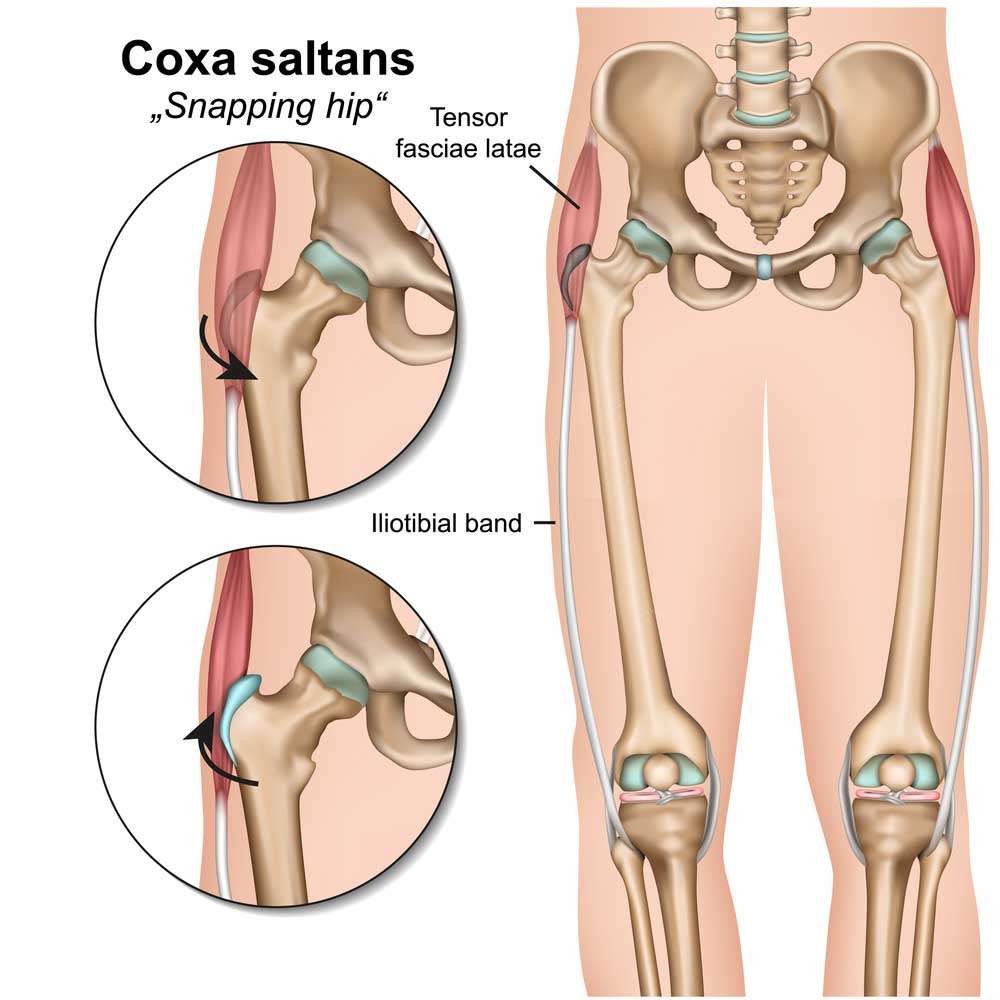Snapping Hip Syndrome Specialist

Are you experiencing a hip which pops, clicks or snaps during particular movements? If so, you may have snapping hip syndrome. Common symptoms include decreased range of motion in the hip, weakness in the leg, and swelling in the front, back or side of the hip. Snapping hip syndrome specialist, Dr. Benedict Nwachukwu provides diagnosis as well as surgical and nonsurgical treatment options for patients in Manhattan, New York City, NY who have developed snapping hip syndrome. Contact Dr. Nwachukwu’s team today!
What is snapping hip syndrome?
Snapping hip syndrome is a painful condition of the hip that can prevent many athletes from performing at their optimum level. Within the hip, two common things that “snap” or “pop” are the iliopsoas tendon and the iliotibial band. These are structures residing outside of the actual hip joint. Patients in Manhattan, New York City and the surrounding New York boroughs might experience a sharp, stabbing pain, or a sensation of catching, popping or locking of the hip. This could be from many different hip joint problems, but is commonly due to tendons catching on a bony prominence and “snapping” when the hip is moved. Dr. Benedict Nwachukwu, orthopedic hip surgeon, specializes in snapping hip syndrome and can treat individuals and athletes who are experiencing hip joint problems.

Are there different types of snapping hip syndrome?
Individuals who have a hip that pops, clicks or snaps during particular movements may have snapping hip syndrome. For those who experience this uncomfortable sensation and an audible click when they bend at the hip, it is called coxa saltans or “dancer’s hip.” In some individuals, the snapping hip can be seen as the muscles visibly shudder with certain movements. Other individuals may just feel a catching in their hip joint. Each of these symptoms is classified into three types of snapping hip:
External snapping hip syndrome is associated with the iliotibial band (ITB). This wide, thick tendon runs along the outside of the hip joint and the outer thigh area (from the pelvis to below the knee). While the iliotibial band is very important for stabilizing the knee, especially during certain activities such as running, it is also very important to the hip joint. When this tendon becomes tight, it can limit flexibility of the hip rotators and rub over a bony structure outside of the hip joint, the greater trochanter, causing snapping sounds and inflammation of associated tissue.
External snapping hip syndrome is not always associated with pain, and some athletes who have a popping sensation may still be able to compete in their sport. However, if persistent pain and weakness occurs with the hip popping and snapping, many of these individuals will often need to seek treatment in order to return to their peak performance level.
Internal snapping hip syndrome is associated with the iliopsoas tendon. This tendon connects two inner hip muscles called the iliacus and psoas muscles to the femur (thighbone) and moves over a protrusion of the pelvic bone called the iliopectineal eminence. The tendon inserts below the hip joint, on the lesser trochanter of the femur. The tendon flipping back and forth across the front of the hip can often produce an audible “clunk” that can be heard, although other times it is more subtle. Typically, the clunking sensation occurs as the hip goes from a flexed to an extended position. This is present normally in 5 to 10% of the population and is not an indication of progressive damage or future problems.
Cartilage injury snapping hip may develop suddenly and may be caused by a fall, direct hit or other trauma. This type of snapping hip is often accompanied by a catching sensation and a limited range of motion. Cartilage injuries that may cause snapping hip syndrome are:
-
- Acetabular Labral Tear – Injury to the cartilage that forms the tough, flexible ring around the hip socket which holds the ball of the femur (thigh bone) within the joint.
- Articular Cartilage Damage – The fibrocartilage that covers the ends of the bones and allows them to move smoothly and painlessly against each other.
- Loose Bodies – Fragmented tissue or bone that breaks away from its correct position and can be caused by trauma. These fragments or pieces of tissue can get caught in the hip and ball socket of the hip, causing catching or a snapping sensation. People who have snapping hip syndrome with painful symptoms should consult an orthopedic hip specialist. This medical professional can give an accurate diagnosis and help develop a treatment plan to alleviate pain and minimize possible future joint damage.
What is the most common cause of snapping hip syndrome?
For patients in New York, snapping hip conditions are often an overuse sports injury. This condition can be caused by vigorous activity and repetitive motion with limited stretching and rest. Snapping hip syndrome can also occasionally occur from injury or trauma to the hip with popping that can become painful. This can usually be managed with conservative treatment. The most important first step is to see an orthopedic hip specialist like Dr. Nwachukwu who can identify factors that tend to worsen the symptoms and create a plan to modify the activities for a temporary period of time until the discomfort resolves.
What are the symptoms of snapping hip syndrome?
Individuals most often report the following symptoms with snapping hip syndrome:
- Snapping or popping in the front, back, or side of the hip that is most noticeable when lifting, rotating, lowering or swinging the leg.
- Decreased range of motion in the hip.
- Weakness in the leg, especially when lifting forward or to the side.
- Swelling in the front, back or side of the hip.
- Increased pain after activity that may subside when resting from the movement.
- Warmth that can be felt in the hip.
- Difficulty running jumping or performing tasks without pain.
- A grinding, snapping or popping sensation in the joint with movement.
How is snapping hip syndrome diagnosed?
Many times, Dr. Nwachukwu will be able to diagnose a patient with a snapping hip condition after a very thorough physical exam where the patient is placed in various positions to determine alignment, pain level and measure flexibility. Dr. Nwachukwu will most likely order an X-ray, or in some cases an MRI scan, so he can visually see inside the hip region to determine if any other underlying condition exists, such as loose bodies, an impingement or a damaged cartilage.
How is snapping hip syndrome treated?
Non-Surgical Treatment:
Snapping hip syndrome is a condition that often can resolve on its own, but the patient must be diligent and modify activities so the injury can heal. Exercises that aggravate the affected tendon should be avoided. Ice, anti-inflammatory medication, massage therapy and a thorough stretching program will also help to heal the injury as well as prevent future re-injury. In some athletes, 4-6 weeks will be enough time to properly heal this injury, but in more chronic cases, it may take months.
Surgical Treatment:
Surgery may be recommended in patients with snapping hip syndrome if another underlying condition exists within the hip, such as FAI (Femoroacetabular impingement) loose bodies or damaged cartilage. In more cases than not, a conservative treatment approach will correct a snapping hip. Dr. Nwachukwu uses arthroscopic hip surgery in patients who do require surgery. Each case is different and he will customize his treatment to the specific needs of the patient.
What happens after surgery for snapping hip syndrome?
For patients who do undergo surgery, it is very important to follow the protocol for post-op recovery as set forth by Dr. Nwachukwu. He will provide a well-supervised physical therapy program following arthroscopic hip surgery so that normal range of motion and mobility can be achieved, as well as pain-free function.
For more information on snapping hip syndrome, or for additional resources on common hip injuries, please contact the office of Benedict Nwachukwu, MD, orthopedic hip specialist serving Manhattan, New York City and surrounding New York boroughs.





